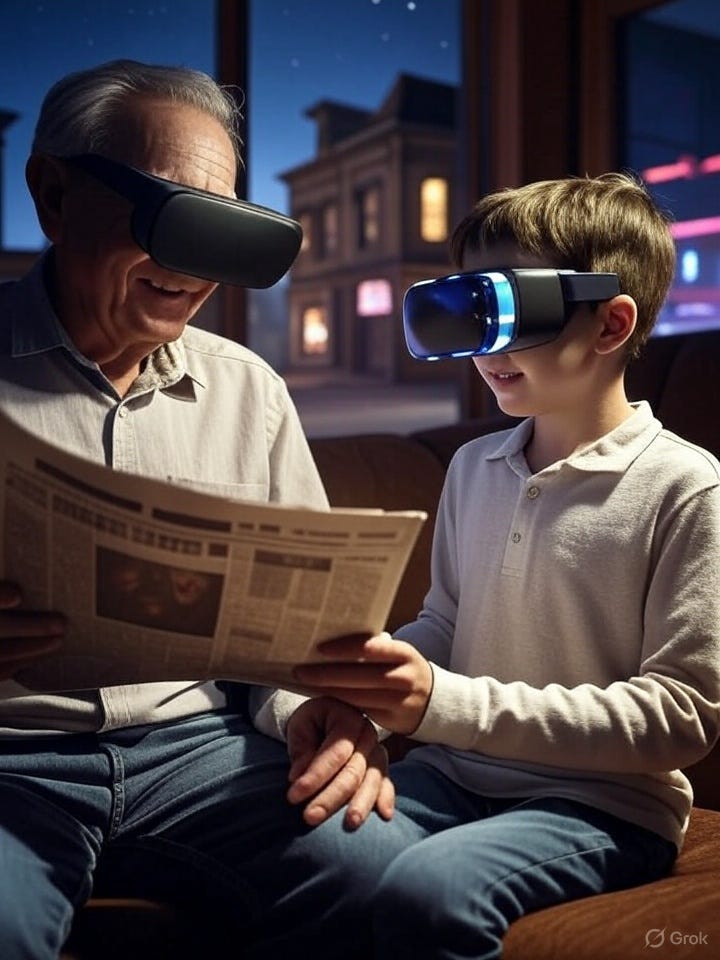Imagine a Saturday morning, the cool breeze slipping through the window as a ten-year-old boy sits at the dining table. Before him, his grandfather unfolds a newspaper, that almost sacred weekend ritual: the rustle of pages, the faint scent of ink, and the promise of distant worlds in every headline. For that boy, the international section was a portal to the unknown, far more thrilling than the local news that seemed mundane.
Years later, that same boy, now grown, dreams of his own publication, one that blends the magic of those newspapers with the boundless power of modern technology. What if we could transform not just the words, but the very way we experience them? This is the dawn of a new era for print media, a leap toward a future where every article isn’t just read—it’s lived, thanks to artificial intelligence and virtual reality. Welcome to a narrative revolution about to take flight.
The Magic of Paper, Reimagined
There’s something profoundly special about newspapers and magazines, a legacy many of us hold dear. For me, it all began with my grandfather: watching him every Saturday buy the salmon-colored financial newspaper, sit with his head propped on his hand, and devour its pages for hours. That scene taught me to love print media, from the international stories that sparked my imagination to the financial columns that awakened my passion for markets. Reading a newspaper is like holding a book and watching a movie at the same time: the words guide you, but the images and design transport you. Yet, this love for paper doesn’t have to stay in the past. Technology can elevate it, merging that nostalgia with endless possibilities. Imagine a publication that keeps the charm of yesteryear but transforms with every story it tells: a living canvas that combines the best of yesterday with the wonders of tomorrow.
Stories That Change Their Skin
What if a newspaper could adapt to the soul of each article? Picture a story about the American Wild West: the paper takes on sepia tones, the typeface evokes the rugged scrawl of a “Wanted” poster, and perhaps you even hear the distant echo of a desert wind. Then, you flip to a cyberpunk tale: the design glows with vibrant neon, the letters seem to float in a futuristic style, and a soft electronic hum fills the air. This is the essence of a living publication, one that doesn’t settle for a single style but embraces all, depending on what the story demands. The color, the font, the layout, even the sound—everything aligns to create an atmosphere that immerses you in the content. It’s not just about reading; it’s about feeling like you’re inside the world the words describe. With this idea, creativity has no limits, and every article becomes a unique experience, as diverse as imagination itself.
AI: The Creator’s Ally
I’ve always had a vivid imagination, but my skills at drawing or photography have never kept up. However, artificial intelligence has changed that completely. Today, by simply describing what I see in my mind—“a Victorian street at dusk, with gas lamps flickering over cobblestones”—I can generate images that bring my words to life. But AI goes beyond images: it can design layouts, choose fonts, create soundscapes, all in harmony with the story I want to tell. For someone like me, who loves creating but struggles with visual arts, this is liberation. AI doesn’t replace human creativity; it amplifies it, becoming an tireless muse that turns ideas into tangible realities. It’s the perfect partner for any writer, journalist, or dreamer who wants to build worlds without the barriers of the past. With these tools, the only limit is what you can imagine.
Living the Stories: The Leap to Virtual Reality
Now, imagine something even grander: putting on a virtual reality headset and not just reading about a space expedition, but walking among the stars, feeling the chill of the void, and hearing the roar of a distant ship. This is what I call “text-to-world,” a technology that turns a simple text into a fully immersive universe. With just a few lines—a prompt—you can generate an entire world, where every detail, from the texture of the ground to the whisper of the wind, is designed to envelop you. It’s the next great step in storytelling: a place where the reader stops being an observer and becomes part of the story. It’s no longer just about newspapers or magazines, but about experiences that transcend paper and screen. This future, powered by AI and VR, will make every article an adventure, every report a journey. We’re on the cusp of a transformation that redefines how we consume and live content.
A Horizon Without End
My dream of owning a newspaper isn’t just an echo of the past; it’s a vision of the future. What began with mornings alongside my grandfather, flipping through pages full of stories, has become a passion for reinventing how those stories reach us. Print media isn’t destined to fade; it’s ready to be reborn, more vibrant and powerful than ever. With technology as our ally, we can create publications that don’t just inform, but transport; worlds that we don’t just read, but inhabit. This is the spirit of effective accelerationism: embracing progress not to leave behind what we love, but to lift it to new heights. So, reader, I invite you to take this leap with me. The next article won’t just be another page—it’ll be an entire universe waiting for you. If you enjoyed this vision, give it a “like,” share it, and I’ll see you in the next chapter. Until soon!













Share this post